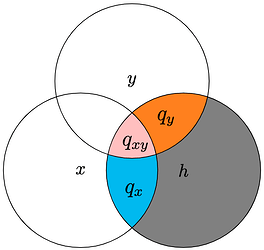Partitioning shared variance among predictors
Gang Chen
In statistical modeling, it is sometimes valuable to dissect the variance of a response variable among multiple predictors. A key metric for this purpose is the coefficient of determination, denoted as R^2. This metric quantifies the proportion of variability in the response variable that can be attributed to one or more predictors. For a comprehensive understanding of its definition and practical applications, refer to the Wikipedia page.
In this specific context, we derive the partitioning of R^2 when dealing with two or three predictors. Our approach draws inspiration from a tutorial by Peter E. Kennedy, which employs Venn diagrams for visual representation during derivation. It is important to interpret the R^2 value in terms of the predictivity associated with a variable. However, more powerful interpretability arises from the causal inference perspective based on the causal relationships among variables.
Three variables: x, y and h
Suppose a regression model for the response variable h is constructed with x and y as two predictors. Assume that R_{x(x)}^2 and R_{y(y)}^2 are the coefficients of determination for the models h\sim x and h\sim y (using the Wilkinson notation), respectively, while R_{x(xy)}^2 and R_{y(xy)}^2 are the coefficients of partial determination for the model h\sim x+ y. In other orders, the four coefficients of determination are associated with the following three models:
Assume that the unique proportion of variability that variable x accounts for in h is q_x. Similarly, the unique proportion of variability that variable y contributes to z is q_y. Lastly, the shared (or common) proportion of variability that variables x and y contribute together to h is q_{xy}. These three proportions can conceptually represented by the following Venn diagram:
The above pictorial representation intuitively results in the following relationships:
Solving the above simultaneous equations leads to
Four variables: x, y, z and h
Suppose a regression model for the response variable h is constructed with x, y and z as three predictors. Following the same notation convention as the case with three variables above, we associate twelve coefficients of determination with the following seven models:
There are seven partitioned proportions of variability that are of interest in this case. Assume that the unique proportions of variability that variables x, y and z account for in h are q_x, q_y and q_z. Similarly, the shared proportion of variability that variables x and y contribute together to h is q_{xy}; the shared proportion of variability that variables x and z contribute together to h is q_{xz}; the shared proportion of variability that variables y and z contribute together to h is q_{yz}. Lastly, the shared proportion of variability that variables x, y and z contribute together to h is q_{xyz}.
These seven proportions likely lend themselves to a graphic representation through a Venn diagram, although I haven’t yet crafted an elegant one. If you have any brilliant suggestions, please don’t hesitate to share! Nonetheless, deriving the following relationships isn’t particularly challenging:
Despite its tedium, algebra can assist in deciphering the equations above and yield the following solutions for the seven partitioning components.
Notice that the coefficients of determination are grouped according to their associated models: those enclosed within a pair of parentheses () correspond to the same model.
